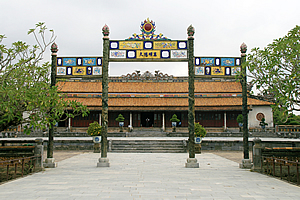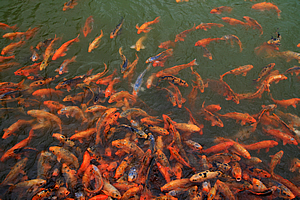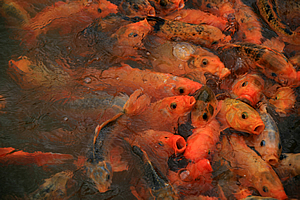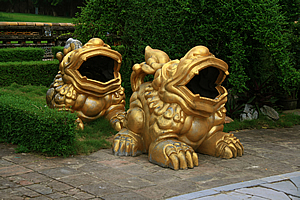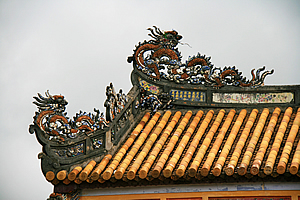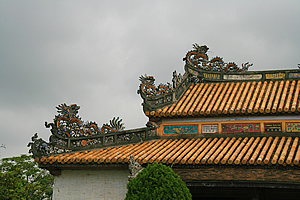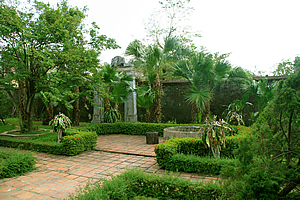--- Archive files ---
Home > Travels > Hue > 2 |
Into the Forbidden City
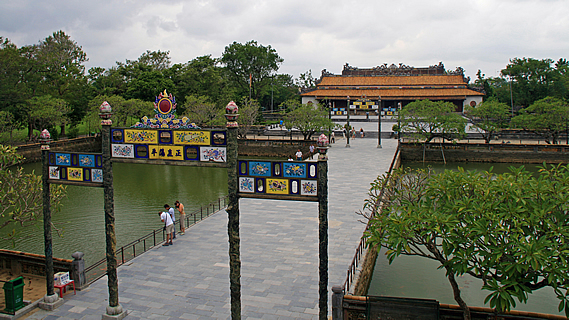
I LOOKED out behind the Ngo Mon building of Hue’s Imperial City into the Purple Forbidden City. A century ago, the Vietnamese emperor would have stood here glancing over his palace before going to the front of the building to address his people. The Forbidden City was a stone city within a stone city where in its day only the chosen few could venture.
The Forbidden City |
A few elaborately carved signposts stood about ten metres away holding up an array of small white and yellow boards with flowers, musical instruments and dancers painted on them in pastel colours. Beyond that a broad path of grey stones went straight out from the tower towards the Hoa Palace which stood two hundred metres ahead. The building had an orange traditional roof on it, in a style similar to the temples I had seen in Japan a couple of years ago. Between the tower and the temple the path passed between two large square ponds of green water.
Competing fish |
We climbed down the stairs from the tower and started following the wide path. We stopped at the left hand pond. There were a few people already there feeding large golden carp. There were countless thousands of them. They were jumping out of the water and crowding together so much that they were completely out of water. They certainly wouldn’t survive very long like this. They were hungry though, and the most aggressive fish were getting the most food.
I imagined these fish had lived and bred in the ponds for hundreds of years. They had adapted the aggressiveness through survival of the fittest. The most aggressive ones were the ones that were best fed, and therefore they were the ones that survived in this extremely competitive environment.
Competing fish |
When the pickings are slim, you do anything to survive, and after a few generations you start to evolve to adapt. Most evolution occurs during tight times such as this when only the fittest will survive. As I would later discover in this trip, the same applied to the people who sold goods in the market places. With a lack of regulation, it was very much an open market here, with the most aggressive traders being the ones who did well in this overly saturated market.
We reached the end of the ponds where we were greeted by a similar totem of poles that we had passed after descending the tower. Both totems were identical. We passed under the totem and climbed a few stone steps to a paved courtyard. On either side of the courtyard at the top of the steps was a small four sided gazebo with a greenish grey stone carved griffin inside it. The griffins appeared quite thin. They faced towards the building we were heading towards, but their heads were turned to face where I was passing. Beyond each griffin the paving stopped giving way to lush uncut grass with large patches of white flowers. About a hundred metres past the start of the grass stood a stone wall.
Gold plated griffins |
In front of the building were four formal wineglass urns with large white and blue glazed pots on top. Each pot had a bonsai tree standing about a metre tall. Now I thought you only find bonsai in Japan, but I was starting to be proved wrong on that one. These trees were even shaped like the small trees in Japanese gardens.
We walked closer to the building. The gardens here were immaculate and very beautiful. There were two Vietnamese gardeners with their distinctive conical straw hats busily maintaining the plants with utmost of care as if they were performing a religious ceremony. They worked amongst two gold plated fat griffin statues that blended in well with the lush green foliage amongst which they perpetually stood.
Decoration on the palace |
Rows of what appeared to be headstones appeared on either side of the path. I’m not sure whether they were headstones or not. They would have been very small. I wondered what their significance was.
I looked at the building before me. The roof was similar in construction as the tower where the kings of old had delivered their messages. The carvings in the ridges were a lot more elaborate though. They were clearly recognisable as dragons. Each dragon was very beautifully carved from wood and stained several colours to blend in perfectly with the logging on the roof. The roof itself had two levels. The lower level gradually sloped upwards. Above it was a short vertical rise with patterned paintings on it. Above that was the upper level of log roofing, but a lot steeper at about forty degrees.
Decoration on the palace |
The building was the Hoa Palace – the emperor’s throne room otherwise known as the Hall of Supreme Harmony. The throne itself was gold plated and incredibly well carved. There were numerous things positioned around the throne room. I’m sure they would have all represented something very important to the Vietnamese royal culture. The columns holding up the roof were red and grey carved into rather intricate patterns. The detail was even more amazing than it had been at the tower. We weren’t allowed to take photography in there.
We passed through the back of the temple out into another large courtyard. The first thing I saw was a large square concrete block about three square metres standing on its end. It was fenced off for construction work. The front of the block was divided into four with a large Chinese symbol embossed into it. As I walked around the block I could see there was a large statue of a gold plated griffin that had been upended for maintenance. What did those characters on the base mean? There must be some importance to these characters as they are not seen when the status is placed the right way up. I imagined other statues and perhaps pots would have similar symbology under their bases.
A large metal cauldron with engraved patterns carved in the inside of the bowl sat near the middle of the courtyard. A paved garden extended out from either side of the courtyard. Each garden had trees and a lot of well positioned foliage.
Garden in the Forbidden City |
Another building graced the back of the courtyard. It was a lot plainer than the throne building, but it had a row of bright purple columns in front of it. We entered the building. It was a museum with displays of all sorts of artefacts. Exhibits included the “statues of ten judicious kings of hell”. According to the popular beliefs of Buddhist karma, these were responsible for examining the deeds of a newly-deceased person in order to dispense punishments for evil acts and rewards for good deeds. The rewards and punishments were provided in the way of a reincarnation to an appropriate creature being.
In times past access to the Forbidden City was very exclusive. Although the decay of time had taken its toll, the exclusive affluence of this city within a city seeped in history was still apparent.
<< Previous | Next >> |
|
||
About this Page
|
||
|
|
|
Where is Walkabout Jeff? |
|
|
|
|
What is happening in Walkabout Jeff's hometown?
|
|
|
|
|
Who is Walkabout Jeff?Any normal person's idea of going out involves going to the local pub for a drink with a few mates. Walkabout Jeff isn't normal.
|
|
|
|
|
